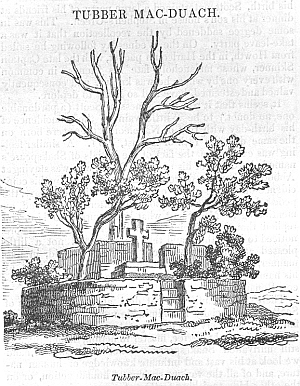Tubber Mac-Duach (Kinvarra, County Galway).
From The Dublin Penny Journal, Volume 1, Number 25, December 15, 1832.
 The place called Tubber-macduach, or Tobar
Mhic-Duach, "the well of
Duach's son," is situate about a quarter of a mile from Kinvarra, in
the County of Galway, on the Loughrea side. Here is a small spring of
water, neatly walled in, and shaded by a few hawthorns, in blighted
contrast with the verdure of which there appears in the background the
remains of a blasted and withered ash, whose aspect indicates that it
has long stood companion to the holy fountain. The upper wall,
apparently of recent erection, is in form a square of about seven feet
to the side, having a small stile for the more easy admission of
pilgrims. Beneath the square wall is another of a circular form,
fencing in the whole, as represented in the annexed cut.
The place called Tubber-macduach, or Tobar
Mhic-Duach, "the well of
Duach's son," is situate about a quarter of a mile from Kinvarra, in
the County of Galway, on the Loughrea side. Here is a small spring of
water, neatly walled in, and shaded by a few hawthorns, in blighted
contrast with the verdure of which there appears in the background the
remains of a blasted and withered ash, whose aspect indicates that it
has long stood companion to the holy fountain. The upper wall,
apparently of recent erection, is in form a square of about seven feet
to the side, having a small stile for the more easy admission of
pilgrims. Beneath the square wall is another of a circular form,
fencing in the whole, as represented in the annexed cut.
On the left hand side as you enter by the stile, you find in the interior of the upper wall a small niche, intended for holding a cup, and also serving as a receptacle for the offerings of devotees. Unfortunately for the guardians of the place, however, such tributes now consist of nothing more than a few worthless rags, brass pins, and the like. Mr. Sheehan, who when I visited this spot, resided hard by, caused a handsome stone cross to be erected in front of the well, between it and the high road, and the exertions of the parish priest, (Rev. Mr. Quinn,) were not wanting on the pious occasion.
This well seems to have been formerly the resort of St. Colman, who flourished about the beginning of the seventh century. He was a member of the illustrious house of Hua-Fiacra-Aidne, in Connaught, and was a near relative to Guare,[1] King of that Province, who began his reign about the year 604, and held the sceptre thirty-eight years. The saint was, from his father's name, Duach, surnamed Mac-Duach, by which appellation he is more generally known than by that of Colman.
The earliest accounts of Colman's life say that he lived as a hermit in the forests of Burrin, County Clare, attended only by one young clerk, his disciple. Their food was water-cresses and wild herbs--their drink the pure spring--and deer-skins served them for clothes. Having constructed a habitation and oratory encircled with trees, they remained in Burrin forest seven years, without conversing with any other person.
Colman's reputation becoming very great, he was taken notice of by his relative, Guare, who was a prince[2] of great piety and liberality. He offered Colman as much land as he choosed for the establishment of a religious community, but the Saint, it is said, refused to accept of more than a small spot, on which he afterwards erected a monastery, and where he became bishop. This place was not far from his former habitation, and has, from his name, been called Kilmacduach. The foundation of that church took place in the early part of the reign of Guare, and probably before the year 620. After a life well spent, St. Colman died on the 3d of February, but the precise year of his demise is unknown. His memory is held in high veneration in the diocese of Kilmacduagh.
From what has been already mentioned, the reader will perceive that the hermitage of Colman, alias Mac-Duach, must have been somewhere in the neighbourhood of the fountain just described, which springs in the barony of Kiltartan, part of the ancient Hy-Fiachra-Aidhne. This well is also near the barony of Burrin,[3] in the forests of which St. Colman is said to have secluded himself. It must likewise be remembered, that he and his attendant are reported to have lived upon water and water herbs, both which Tubbermacduach was capable of furnishing them with. I shall only remark farther, that the parish of Kinvarra, or Kinmarra, in which the spring rises, is a prebend in the diocese[4] of Kilmacduach, which See was, as I have already mentioned, founded by St. Colman.
Most probably this well, (like many others of the same description,) was used by the Saint, whose name it bears, for the purpose of baptizing converts to Christianity. Thus Archbishop Usher (Primord. p. 862-3.) says that St. Patrick baptized his converts in Dublin, including Alphin, the king's son, in a well near Patrick's Church, which in after ages became an object of devotion for the faithful, and so continued until it was enclosed within the foundation of a house, in the 17th century.[5]
B.
NOTES:-
[1] Guare's father was Colman, son of Cobhtach, who was cousin-german of Duach, the father of Saint Colman.-- Vide Colg. A.A.S.S. p. 248.
[2] 2. Lanigan's Eccl. Hist, Tr. 342.
[3] Burren barony was formerly denominated Hy-Lochlean, and was part of Corcumruaidhe district. The ancient proprietors of it were the O'Loghlins, of the race of Ir, by Fergus-Riogh and Maude, Queen of Connaught.--See Seward Top. Hib. title Burren, and Macgeogh. Hist. d'Irl. fo. 215.
[4] Harris's Ware's Bishops at Kilmacduach.
[5] See 1. Mac Geoghagan Hist. d'Irl. 258. to the like effect.
